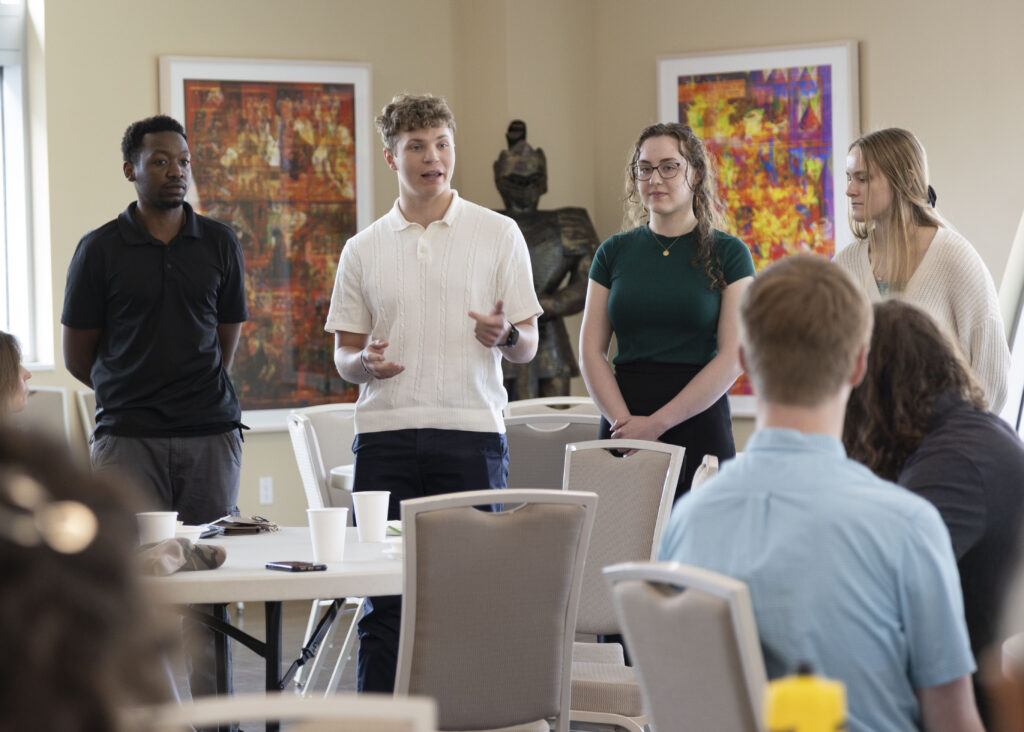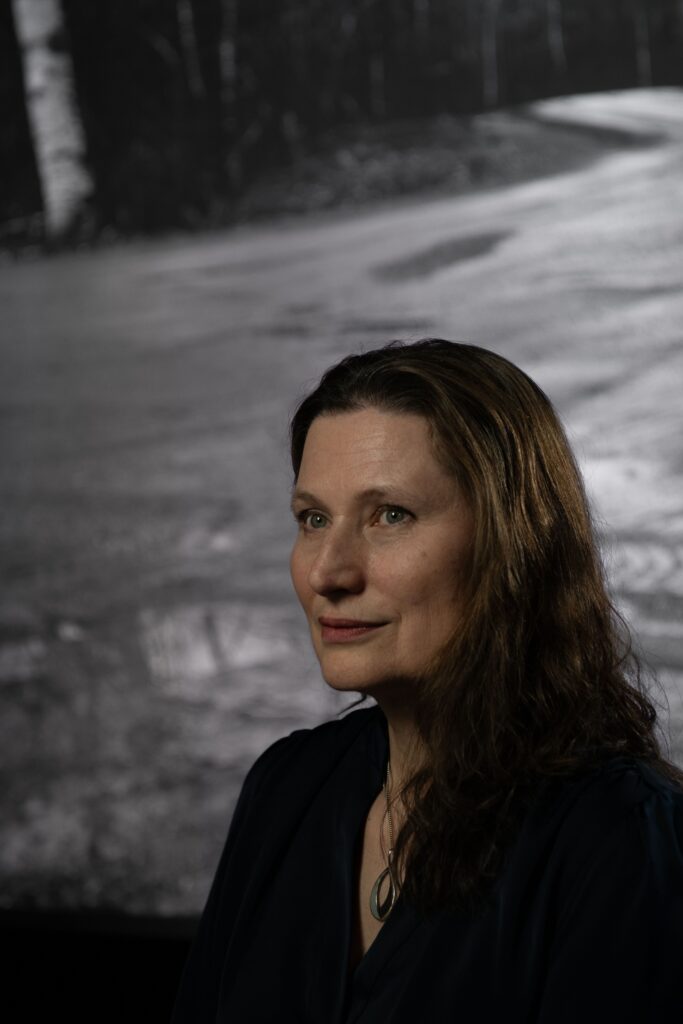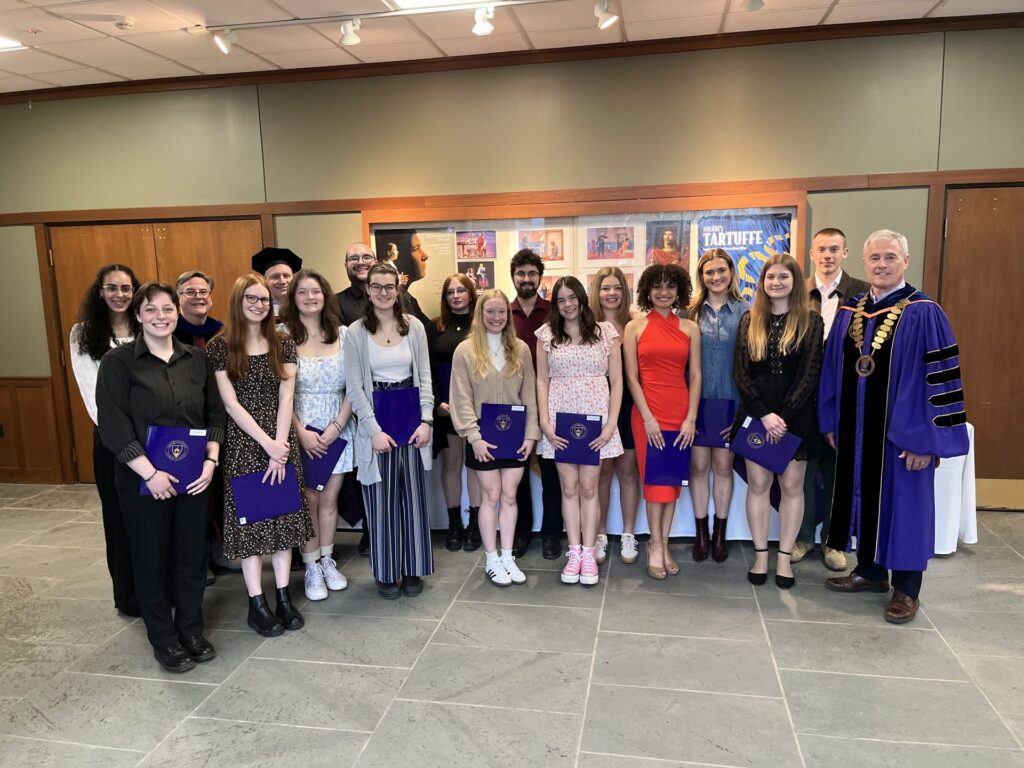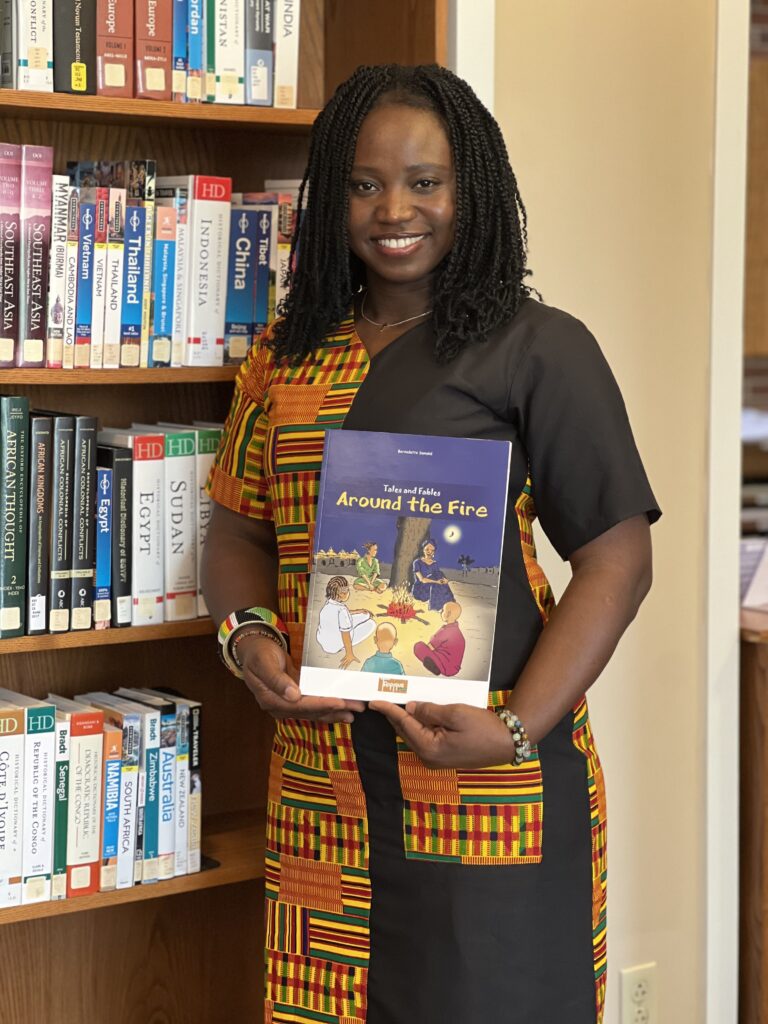Speaker relates racial violence of history to present times
Judge and author Margaret Burnham tells nearly 100 at Sutherland Lecture about her book on long unknown Jim Crow era stories and their lessons for society today

Margaret Burnham presents Tuesday’s Sutherland Lecture in McCarthy Recital Hall (photos by Patrick Bohan)
“We come together at a time when we are all saying the name of Tyre Nichols in Memphis, standing with his family and friends and thinking about the loss of life that continues to characterize and scar our country,” said Margaret Burnham, a judge, civil rights activist and author who delivered Tuesday’s Sutherland Lecture at Saint Michael’s College.
By Hands Now Known: Jim Crow’s Legal Executioners, Burnham’s acclaimed 2022 book that focused her late afternoon Tuesday talk, documents mid-20th-century violence against African Americans in the Jim Crow era. Sadly, she told nearly 100 gathered in the McCarthy Recital Hall, such violence is “an ongoing crisis and defining feature of our country today.”
Burnham’s talk also served as the College’s keynote address for January programs honoring the legacy of Dr. Martin Luther King Jr. Opening the program was Saint Michael’s Dean of Faculty Gretchen Galbraith, who connected with Burnham as a fellow historian. Kelechi Onuoha, Student Government Association president on campus, formally introduced the speaker, who warmly thanked her, Galbraith and President Lorraine Sterritt, who attended too, for the invitation to speak. Dean Galbraith noted that Denise and Paige Sutherland, of the family that has endowed this annual lecture since 1998, were watching via a livestream that ended up having nearly 50 more viewers tune in.

Dean Gretchen Galbraith opens the program.
Burnham book-ended her well-received talk of just over an hour with tragically affecting human stories of Jim Crow era violence victims — Ollie Hunter in Georgia in the 1940s and Edwin Williams near New Orleans in about the same era — dramatizing through personal individual details the relatable humanity of what otherwise can feel like overwhelming cold and numbing statistics. The audience gave a standing ovation after the presentation prior to a short question and answer period. The speaker later signed books for audience members while visiting with them in the lobby.
Her introducers related how Burnham began her career at the NAACP Legal Defense and Education Fund and in 1977; she became the first African American woman to serve as a judge in Massachusetts. She is currently a University Distinguished Professor of Law at Northeastern University, and she founded the university’s Civil Rights and Restorative Justice Project (CRRJ) within its School of Law. Through CRRJ, Burnham has led teams of law students in investigating acts of racial violence in the Jim Crow era. The project serves as a resource for scholars, policymakers and organizers involved in initiatives seeking justice for these crimes. She is also a Carnegie Fellow and is among four scholars appointed by President Joe Biden to serve on the Civil Rights Cold Case Records Review Board, which reviews records of murders and racially motivated violence that occurred between 1940 and 1979.

Kelechi Onuoha ’23 introduces Margaret Burnham.
Burnham said a theme in her book that resonates today is resistance, with a continuum of resistance to oppression of African Americans that starts in 1619. She looks at the “dynamics of the dimensions of resistance in the Jim Crow period, and “those are interwoven themes that speak to what we confront today.” Using the Nichols case — and before it from recent years, George Floyd, Breonna Taylor and Trayvon Martin as examples — she said American society continues to grapple with violent police crimes and hate crimes and to dispute what the federal role should be in such matters, much as in earlier eras. Coming to terms with those things is part of an effort by many citizens to “grow as communities of learners and activists, to build and reshape in accordance with the needs of the moments.”
She told how she began in earnest her research for the book in 2007 when the U.S. Congress took up a bill named for Emmett Till, the well-known teen victim of a 1955 lynching, to reopen old cases that still might be prosecuted. One such case that emerged of two young men lynched in Mississippi by the Klan while hitchhiking in 1964 when Burnham was a civil rights worker there spurred her to dig further, “since I had a personal relationship with the case having been there at the time.” Her purpose became “to expand their experience of justice, to restore justice as best I could,” she said.
Her work with colleagues relating to the Till bill led them to discover “basically a hole in our history, a space where historians had not really fully examined who we lost.” So began a long process of clipping from Black newspapers across the U.S. about little known (long suppressed) cases gathering data, combing archives, and bringing varied expertise with colleagues from angles of law, politics and sociology and other perspectives.
One case they came upon was that of Ollie Hunter, (1889 – 1944), domestic laborer who was killed by an unidentified white store manager in Seminole County, Georgia. Hunter picked up a can while in the store and was told by the manager not to handle the articles. She sat the can down and walked out of the store. The manager followed Hunter and struck her in the head with an ax handle. The only account they could find anywhere of this was a letter in an archive from a witness named “Rayburn.” It made Burnham and colleagues wonder, “How many Ollie Hunters are out there, and don’t they deserve to be lifted up, restored, and named?’

A standing ovation for the speaker.
Soon she and colleagues brought students into their research on such cases all over the country. When they reached out to victims’ family members, their response usually was “I thought I’d never get this call” — they are “eager and grateful to work with us to fully understand what happened to their loved ones.”
Other cases led to further knowledge about the experiences of those in flight from oppression to northern sanctuary communities — first from slavery and later in Jim Crow, seeking supportive communities where they might live in peace. (Burnham briefly related some aspects of these stories to current stories of immigrants trying to improve their lives in coming to the U.S.)
One disturbing tale the researchers found of this type was of a man from New Orleans who had moved to Detroit and built a life working in an auto factory. But police officers from New Orleans pursued him there 10 years later him over a specious allegation of his supposed role in a policeman’s death, and took him back – rendition as it is called – and the man was dead the next day at the hands of the police, “taken for a ride.”

Books for signing in the lobby before and after the talk.
Much of her book, she said, “is about the way law failed us during this period,” going back to the years right after the Civil War. After a brief proud moment just following the war that saw the 13th through 15th amendments further enshrining the rights of all Americans to be free from violence, the tide tragically turned. Klan terror, expanding oppressive state and local government policies and widespread lynching marked generations well into the 1960s when people took to the streets and, finally brought passage of civil rights legislation. Further, it was only in the 1990s that Congress got around to passing hate crime legislation giving federal government somewhat more power to deal with incidents like the recent Memphis killing, she said.
Burnham closed her talk with the story of Edwin Williams. On April 27, 1943, Edwin Clifford Williams, Sr., was killed when he dared to defend his family from an assault perpetrated by three white U.S. Navy Sailors in Algiers, Louisiana. Despite the brave efforts of his wife, Lillian Alveris Williams, the family never received justice. However, a student investigated the case in a Civil Rights and Restorative Justice Clinic in 2020-2021. On Juneteenth 2022, the family of Mr. Williams, in partnership with the Civil Rights and Restorative Justice Project and the Louis A. Berry Institute for Civil Rights at Southern University School of Law, hosted an event at Beautiful Zion Baptist Church in Algiers (where the family had been worshipping before the deadly assault) to commemorate his life and legacy. The program included remarks by Mr. Williams’ children and grandchildren, and the unveiling of a historical marker that will be installed where Mr. Williams was killed.
Burnham said after some time her student was able to find the son of the victim — a young boy at the time of the assault, who witnessed it and is now in his 70s and pastor at that very Baptist church. The powerful recent moment of commemoration “added that chapter to our reading of American history, Jim Crow history, and what it was our people endured here at home during World War II,” said the speaker.

Jolivette Anderson-Douoning, Edmundite Scholar-in-Residence in History, asks a question after the presentation.
With that, she welcomed questions. Student Jason Li ‘23 asked what the student body at Saint Michael’s could do that would be meaningful. Burnham said, “What you can do is be responsible for your own political literacy — and then engage in what it is you learned at whatever level in whatever struggle you participate – it will make a difference, and it will enrich your life too and give you a path.”
A student aspiring to a teaching career asked for advice on teaching such history in a state as white as Vermont. Burnham replied that, beyond being willing to tell stories like the one she had just shared, one “can’t find a richer landscape than Black life – all of it, so I try to talk about ways people lived through this and what they created in art or music.” She suggested introducing artistic materials to students, showing paintings and playing music, “so they get a sense of the many points of entry into this material and understand the enormously beautiful, challenging and vast cultural output of African Americans. This is what we do as humans — finding 1,000 different ways of expression.”

Margaret Burnham fields a student question after her talk, as Dean Gretchen Galbraith looks on.






